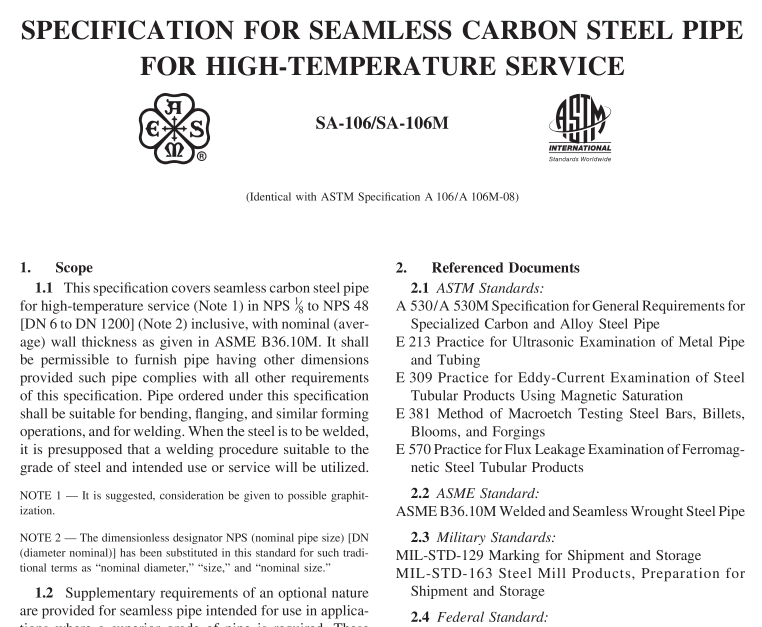ASME SA-106:2019 pdf free download SPECIFICATION FOR SEAMLESS CARBON STEEL PIPE FOR HIGH-TEMPERATURE SERVICE
12. Flattening Tests
12.1 Although testing is not required, pipe shall be capable ofmeeting the flattening test requirements of Sup- plementary Requirement S3, if tested.
13. Hydrostatic Test
13.1 Except as allowed by 13.2, 13.3, and 13.4, each length of pipe shall be subjected to the hydrostatic test without leakage through the pipe wall.
13.2 As an alternative to the hydrostatic test at the option of the manufacturer or where specified in the pur- chase order, it shall be permissible for the full body of each pipe to be tested with a nondestructive electric test described in Section 14.
13.3 Where specified in the purchase order, it shall be permissible for pipe to be furnished without the hydrostatic test and without the nondestructive electric test in Section 14; in this case, each length so furnished shall include the mandatory marking ofthe letters “NH.” It shall be permissible for pipe meeting the requirements of 13.1 or13.2 to be furnished where pipe withouteitherthe hydro- static or nondestructive electric test has been specified in the purchase order; in this case, such pipe need not be marked with the letters “NH.” Pipe that has failed either the hydrostatic test of 13.1 or the nondestructive electric test of 13.2 shall not be furnished as “NH” pipe. 13.4 Where the hydrostatic test and the nondestructive electric test are omitted and the lengths marked with the letters “NH,” the certification, where required, shall clearly state “Not Hydrostatically Tested,” and the letters “NH” shall be appended to the product specification number and material grade shown on the certification.
14 Nondestructive Electric Test 14.1 As an alternative to the hydrostatic test at the option of the manufacturer or where specified in the pur- chase order as an alternative or addition to the hydrostatic test, the full body of each pipe shall be tested with a nondestructive electric test in accordance with Practice E 213, E 309, or E 570. In such cases, the marking of each length ofpipe so furnished shall include the letters “NDE.” It is the intent of this nondestructive electric test to reject pipe with imperfections that produce test signals equal to or greater than that produced by the applicable calibration standard.
14.2 Where the nondestructive electric test is per- formed, thelengths shall bemarkedwith the letters “NDE.” The certification, where required, shall state “Nondestruc- tive Electric Tested” and shall indicate which of the tests was applied. Also, the letters “NDE” shall be appended to the product specification number and material grade shown on the certification.
14.3 The following information is for the benefit of the user of this specification:
14.3.1 The reference standards defined in 14.4 through 14.6 are convenient standards for calibration of nondestructive testing equipment. The dimensions of such standards are not to be construed as the minimum sizes of imperfections detectable by such equipment.
14.3.2 The ultrasonic testing referred to in this speci- fication is capable of detecting the presence and location of significant longitudinally or circumferentially oriented imperfections: however, different techniques need to be employed for the detection of such differently oriented imperfections. Ultrasonic testing is not necessarily capable of detecting short, deep imperfections.
14.3.3 The eddy current examination referenced in this specification has the capability of detecting significant imperfections, especially of the short abrupt type.
14.3.4 The flux leakage examination referred to in this specification is capable of detecting the presence and location of significant longitudinally or transversely ori- ented imperfections: however, different techniques need to be employed for the detection of such differently oriented imperfections.
14.3.5 The hydrostatic test referred to in Section 13 has the capability of finding defects of a size permitting the testfluid to leakthrough the tube wall and may be either visually seen or detected by a loss ofpressure. Hydrostatic testing is not necessarily capable of detecting very tight, through-the-wall imperfections or imperfections that extend an appreciable distance into the wall without com- plete penetration.
14.3.6 A purchaser interested in ascertaining the nature (type, size, location, and orientation) of discontinu- ities that can be detected in the specific applications of these examinations is directed to discuss this with the man- ufacturer of the tubular product.
14.4 For ultrasonic testing, the calibration reference notches shall be, at the option of the producer, any one of the three common notch shapes shown in Practice E 213.
ASME SA-106:2019 pdf free download
